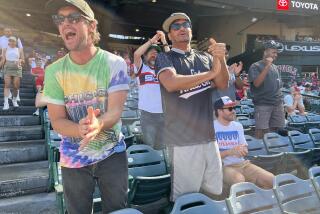A ‘Baseball Palace’ to Be Paved Over
- Share via
CHICAGO — At 80 years, Comiskey Park is the oldest major-league ballpark and the only one remaining where Cy Young pitched. It is where Babe Ruth homered to win the first All-Star Game and Bob Feller pitched the only Opening Day no-hitter.
Cherish such memories, though, because after Sunday’s game between the Seattle Mariners and the Chicago White Sox, the next ball seen in Comiskey Park will be a wrecking ball.
The “Baseball Palace of the World,” as it was touted when built at the corner of Shields Avenue and 35th Street in 1910, will be razed next month.
A new Comiskey Park -- across 35th Street -- will be completed for next season. The original will be a parking lot.
“I was the first black to play with the White Sox in 1951,” Minnie Minoso said. “I hit a homer on the first pitch off the Yankees’ Vic Raschi. From the first day, the fans were great. Friendship is like a glass. You have to polish and protect it or it will be shattered. I’ll always think of Comiskey that way, even after it’s gone.”
Comiskey Park is one of the great cathedrals of baseball, one of a class that has dwindled to a precious few. Fenway Park in Boston, Tiger Stadium in Detroit and Wrigley Field in Chicago’s North side are the only remaining major-league parks built before World War I.
With Comiskey Park’s demise, there will be one fewer link -- like Ebbets Field, the Polo Grounds, Sportsman’s Park, Connie Mack Stadium, Crosley Field and Forbes Field -- to baseball’s generations, one less place where history resonates.
Comiskey Park is not revered like Fenway Park with its Green Monster, and it’s not charming like Wrigley Field with its ivy-covered outfield wall.
Comiskey Park is a lunch-pail place, in the South side, “in the baddest part of town.”
Forty-one iron girders obstruct the views of fans. The park’s electrical, television, radio, water and drainage life support systems are an exposed web of grime-layered membranes hanging from the ceilings. Paint is peeling. Corridors are narrow. Water seeps through cracks in the five levels of concrete.
These furrows reveal Comiskey’s age.
Look beyond these lines to appreciate its uniqueness: The shower and barber chair: Both are in the center-field bleachers. Pull the chain and get cooling relief on a scorching day. Or sit and get a shave and haircut while watching the game. The center-field scoreboard: Fireworks and smoke spew from the scoreboard and nine pinwheels whirl after each White Sox homer.
On June 9, 1974, the Boston Red Sox’s Tommy Harper jumped against the left-field wall, but hit his head against the wall’s protrusion. With Ron Santo circling the bases for an inside-the-park homer, the fireworks were exploding as the unconscious Harper lie on the turf.
In answer to the fireworks in the early 1960s, New York Yankees’ Manager Casey Stengel often would light and wave sparklers in the dugout after a Yankees’ homer.
In 1960, Jimmy Piersall was fined $250 by American League President Joe Cronin for throwing a baseball at the scoreboard.
The scoreboard, built in 1960 under the direction of colorful owner Bill Veeck, probably will be donated to, or purchased by, a university or college. One of the reported candidates is Notre Dame.
The lighthouse stairwell: It’s in the vestibule of the White Sox’ locker room, and is where players can climb one level and walk down a hallway to a batting cage. It also has been used, at times, as a players’ escape route from frustrated or autograph-seeking fans.
The clubhouse: “Shoeless” Joe Jackson, Ted Lyons, Luis Aparicio and Billy Pierce dressed in the closet-like White Sox side. And in the even-smaller visiting clubhouse, Ruth, Ted Williams, Ty Cobb, Reggie Jackson and Walter Johnson laced up their spikes.
The distinctive arches: On the outside of park’s lower circumference, the arches liken Comiskey to the Roman Coliseum. But the “Old Roman” himself, White Sox owner Charles A. Comiskey, built the park when William Taft was president and Ruth was 15 years old.
The spacious dimensions: Originally, the fence was 363 feet down the lines and 420 to center. Today it is 347 down each line -- the longest in the American League -- and 409 to center.
Minoso, baseball’s only five-decade player, looks from the White Sox dugout and says, “You’ll always have memories, but it’s time. It’s time for a new park.”
Engineers say Comiskey is ready to totter. No major park renovations can be done because it is not structurally sound. It is too small for office, player and maintenance personnel.
Pieces of baseball history will be auctioned to benefit local charities.
Home plate, the pitching rubber, bases and other prized objects will be placed in the White Sox Hall of Fame.
“Each player is supposed to get a few seats,” infielder Steve Lyons says. “I’ll never give them up. I’ll pass them on to my children.”
The new Comiskey, which rises above its predescessor, will be a baseball-only grass-field park that will seat 43,000. It will have a new scoreboard in center field. And yes, it will be an exploding one. The new Comiskey will not resemble other multipurpose stadiums, like Three Rivers, Riverfront and Veterans.
Some of the old Comiskey will be in the new, such as the arch design and infield dirt.
“Comiskey is here now, but when we come back next spring, then it will really hit us,” Lyons said while sitting in the clubhouse. “Next year I’ll be standing in this same spot saying: ‘ “Yes, there used to be a ballpark right here.’ ”
More to Read
Go beyond the scoreboard
Get the latest on L.A.'s teams in the daily Sports Report newsletter.
You may occasionally receive promotional content from the Los Angeles Times.










